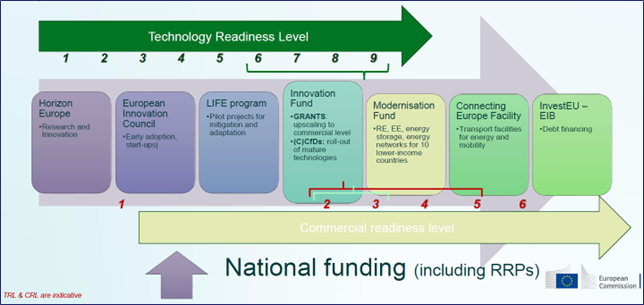July 10, 2024
Understanding the Role of TRL in IF Project Selection
In recent days, the DIAMONDS4IF project partners have completed and submitted several deliverables as requested in the Grant Agreement. Among those also the “Report on Selection Approach and Framework” has been submitted. This latter details the creation of an initial list of relevant projects from H2020 databases for the upcoming Innovation Fund (IF) calls.
The process of identifying and selecting new potential candidates for the next IF calls, involves searching among project´s ideas and partners who have previously participated in Horizon 2020 projects (the predecessor of Horizon Europe). The goal of these H2020-projects was to fund and support research and innovation. Instead, the IF aims at the demonstration and upscaling of the most innovative technologies to bring them to market, i.e. through investment support.
H2020 and Horizon Europe, by definition, included projects with a lower technological maturity and related lower Commercial Readiness Levels (CRLs) compared to those applying for the Innovation Fund. In this sense, the Technology Readiness Level (TRL) is a crucial factor in the selection of projects that wish to apply for the IF. And any “pipeline” that aspires to make the transition from research to market, involving the development of ideas, research, results, and exploitation, must therefore focus on exploitable results.
But let’s clarify what we mean exactly when we talk about TRL.
The TRLs refers to a measurement system used to assess the maturity level of a particular technology. The scale ranges from 1 to 9 and is one of the tools needed to manage the progress of research and development activity within an organization. This measurement system is also very useful to define which steps should be taken in order to bring the research result to the market.
The TRL was developed at NASA (USA) during the 1970s and was introduced and implemented in EU-funded projects in 2012 to better define and sustain the framework program called H2020, which ran from 2013 to 2020. TRL is currently the point of reference for determining the development or maturity of research and its readiness for market uptake and potential investments. It is important to emphasize that the TRL scale is self-declared and may differ from sector to sector. However, the European Commission underlines that, where a topic description refers to a TRL, the following definitions apply, unless otherwise specified:
TRL 1 – Basic principles observed
TRL 2 – Technology concept formulated
TRL 3 – Experimental proof of concept
TRL 4 – Technology validated in a laboratory environment
TRL 5 – Technology validated in relevant environment
TRL 6 – Technology demonstrated in relevant environment
TRL 7 – System prototype demonstration in operational environment
TRL 8 – System completed and qualified
TRL 9 – Actual system proven in operational environment (competitive manufacturing in the case of key enabling technologies; or in space).
We can summarize by saying that TRLs 1-3 represent the initial steps of research activities and their preclinical studies. TRLs 4-6 encompass the stages of product development. TRLs 7-8 represent the pre-commercial scale steps of the product’s prototype. TRL 9 represents the level at which the technology is released, industrial production is started, and the product is launched on the market.
Understanding these levels helps in aligning project goals with expected technological and commercial outcomes. However, also the scale for CRL is yet not well-defined and is also not officially established.
One of the main criteria for a project’s application to the IF is its degree of innovation in relation to the commercial and technological state-of-the-art at the European level. Projects must therefore include the scaling up of innovative technologies and compare with established competitive solutions. For any new solution to be provided for IF, technical, operational, and financial maturity must be assessed.
The degree of innovation is evaluated first, and if the threshold is not met, the evaluation will be stopped. This refers also to the level of technical maturity. Additionally, operational maturity must be proven by progress in planning and implementation, including permitting procedures and contracts with customers and suppliers. This is why projects aiming to apply should position themselves at TRL´s levels 6 to 9.
The definition of TRLs for projects selected by DIAMONDS4IF partners from the H2020 database has been a fundamental element in defining the selection approach in the previously mentioned deliverable, as well as in developing a scoring method to identify potential eligible candidates.
Image Source: Maria Alfayate, Deputy Head of Unit, CINEA (2024). H2020´ image added by PNO
EU-Förderprogramme, von denen Sie profitieren können (pnoconsultants.com)

